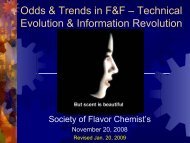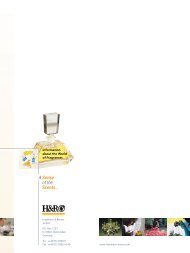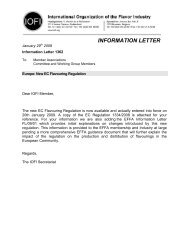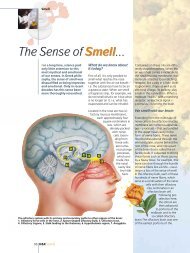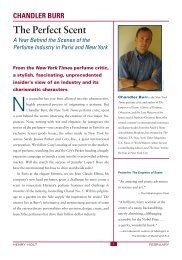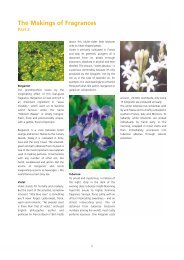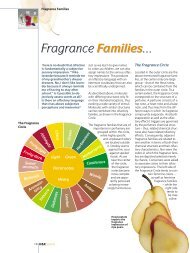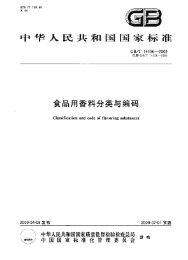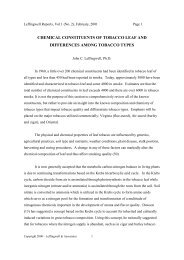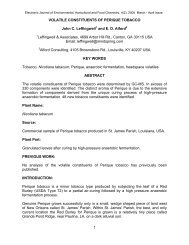Flavor Properties of FEMA GRAS List 25 Flavor Chemicals flavor
Flavor Properties of FEMA GRAS List 25 Flavor Chemicals flavor
Flavor Properties of FEMA GRAS List 25 Flavor Chemicals flavor
Create successful ePaper yourself
Turn your PDF publications into a flip-book with our unique Google optimized e-Paper software.
<strong>flavor</strong><br />
<strong>Flavor</strong> <strong>Properties</strong> <strong>of</strong> <strong>FEMA</strong> <strong>GRAS</strong> <strong>List</strong> <strong>25</strong><br />
<strong>Flavor</strong> <strong>Chemicals</strong> a<br />
A preliminary assessment<br />
John Leffingwell, Leffingwell & Associates b<br />
a www.fema<strong>flavor</strong>.org/uploadedfiles/<strong>GRAS</strong>_<strong>25</strong>_Tables.pdf<br />
b 4699 Arbor Hill Road, Canton, GA; leffingwell@mindspring.com; www.leffingwell.com<br />
This author welcomes additional insights and descriptors for these materials.<br />
24<br />
<strong>FEMA</strong># / CAS# Name Description Structure<br />
<strong>25</strong>66 / 10039-39-1 2-Hexyl-4-<br />
acetoxytetrahydr<strong>of</strong>uran<br />
(Re-<strong>GRAS</strong>)<br />
3211 / 139<strong>25</strong>-08-1 2-Methyl-5-vinylpyrazine<br />
(Re-<strong>GRAS</strong>)<br />
Sweet, floral-fruity odor with a peachapricotlike<br />
taste.<br />
C<strong>of</strong>feelike @ 10 ppm in sugar syrup. 1<br />
4668 / <strong>25</strong>394-57-4 Spilanthol; Affinin;<br />
(2E,4Z,6E)-N-isobutylocta-<br />
2,4,6-trienamide<br />
Imparts salivation, tingling effects,<br />
numbing effects and is perceived<br />
as salty by most persons. A <strong>flavor</strong><br />
enhancer. 2–4<br />
PERFUMER & FLAVORIST VOL. 36 JUNE 2011<br />
4669 / 121746-18-7 4-Amino-5,6-<br />
dimethylthieno[2,3-d]<br />
pyrimidin-2(1H)-one &<br />
hydrochloride salt<br />
Sweetness enhancer and modulator,<br />
especially for sucralose. 5<br />
4670 / 88497-17-0 1,1-Propanedithiol Sulfurous, powerful cooked onion<br />
savory odor.<br />
4671 / 71978-00-2 (Z)-5-Octenyl acetate Odor: Banana tissuelike, melonlike,<br />
green, coarse, fruit fleshlike, fermented.<br />
Taste in water: Bananalike, melonlike,<br />
estery, juicy, pineapplelike, green, fruit<br />
fleshlike (at 2.5 ppm). 6<br />
4672 / 68820-35-9 (E)-4-Undecenal; trans-4-<br />
Undecenal<br />
Fatty, aldehydic with floral, herbaceous,<br />
and some citrus notes.<br />
4673 / 7370-44-7 d-Hexadecalactone Mild, fatty waxy, mild dairy notes; adds<br />
buttery notes/mouthfeel in cream. 7<br />
delta-Hexadecalactone provided a<br />
fatty mouthfeel to an o/w emulsion<br />
(threshold = 190 micromol/L) and a<br />
melted butterlike aroma in whipped<br />
cream (recognition threshold in<br />
whipped cream = 360 micromoles per<br />
kilogram).
<strong>FEMA</strong># / CAS# Name Description Structure<br />
4674 / 4192-90-9 Trilobatin; 1-[4-(b-D-<br />
glucopyranosyloxy)-<br />
2,6-dihydroxyphenyl]-<br />
3-(4-hydroxyphenyl)-1-<br />
propanone<br />
Sweetness enhancer and bitter<br />
blocker. 8,9<br />
4675 / 73-32-5 L-Isoleucine Essentially odorless; used in<br />
reaction <strong>flavor</strong>s and as a nutritional<br />
supplement.<br />
4676 / 58066-86-7 1-(2-Furfurylthio)-2-<br />
propanone<br />
4677 / 1064678-08-5 (±)-4-Methyl-2-propyl-<br />
1,3-oxathiane<br />
Burnt c<strong>of</strong>fee note at 10 ppm in sugar<br />
syrup; cabbage at 3 ppm; mercaptan<br />
note at 6.7 ppm in c<strong>of</strong>fee. 10,11<br />
Odor @ 0.5%: Onion, garlic, powerful,<br />
sweet. <strong>Flavor</strong> pr<strong>of</strong>ile: Pineapple,<br />
milky, mango, grapey, citrus,<br />
bubblegum, melon, orange flower,<br />
cassis, alliaceous, bacon (extremely<br />
strong). 12<br />
<strong>25</strong><br />
4678 / 1003050-<br />
32-5<br />
N-(2-Methylcyclohexyl)-<br />
2,3,4,5,6-<br />
pentafluorobenzamide<br />
Artificial sweetener; sweetness<br />
enhancer for sucrose. 13<br />
4680 / 1120363-<br />
98-5<br />
5-Isopropyl-2,6-diethyl-<br />
2-methyltetrahydro-2Hpyran<br />
Imparts a breath freshening effect. 14<br />
In a particular embodiment the<br />
invention relates to the use <strong>of</strong> these<br />
<strong>flavor</strong>ing substances in <strong>flavor</strong>ing<br />
substance and <strong>flavor</strong>ing compositions<br />
with a freshening effect for use in<br />
oral hygiene products. A preferred<br />
compound for achieving the object<br />
<strong>of</strong> the invention is 2,6-diethyl-5-<br />
isopropyl-2-methyltetrahydropyran.<br />
4681 / 68489-09-8 WS-12; (1R,2S,5R)-N-<br />
(4-Methoxyphenyl)-pmenthanecarboxamide<br />
WS-12 is one <strong>of</strong> the original Wilkinson<br />
Sword cooling agents and is reported<br />
to be as cooling as the WS-3<br />
compound. (Cooling strength <strong>of</strong> 150<br />
as compared to (-)-menthol at 100). 15<br />
More recently, Furrer et al. indicated<br />
that in isointensity measurements<br />
vs 2 ppm menthol, WS-12 was<br />
essentially the same cooling strength<br />
as menthol. 16<br />
4682 / 16423-19-1 Geosmin Intense earthy-musty; green, herbal<br />
note in dilution.
<strong>FEMA</strong># / CAS# Name Description Structure<br />
<strong>flavor</strong><br />
26<br />
4683 / 26486-13-5 2-Methyl-4,5-dihydr<strong>of</strong>uran-<br />
3-thiol<br />
4684 (2S,5R)-N-[4-(2-Amino-<br />
2-oxoethyl)phenyl]-pmenthanecarboxamide<br />
Sulfurous, roasted meat, savory on<br />
dilution. 17<br />
At a level <strong>of</strong> 10 ppm in water this<br />
material contributes moderate throat<br />
and mouth cooling that lingers with<br />
some bitter notes in the background.<br />
Cooling lasts within the breath for 30<br />
minutes. At the level <strong>of</strong> 1 ppm in water<br />
it is clean with slight cooling up front<br />
that builds with time to moderate level.<br />
Cooling lasted for 30 minutes. 18<br />
4685 / 7370-92-5 d-Tridecalactone Fatty, creamy, dairy-butter notes.<br />
4686 / <strong>25</strong>2736-41-7 (±)-2-Methyltetrahydr<strong>of</strong>uran-<br />
3-thiol acetate<br />
Sulfurous, roasted meat.<br />
4687 / 544409-58-7 (±)-3-Hydroxy-3-methyl-2,4-<br />
nonanedione<br />
Imparts a creamy/fatty mouthfeel <strong>flavor</strong>.<br />
It is also able to impart an organoleptic<br />
impression similar the one <strong>of</strong> fresh<br />
brewed green tea. 19<br />
PERFUMER & FLAVORIST VOL. 36 JUNE 2011<br />
4688 / 105-82-8 1,1-Dipropoxyethane Fresh ethereal alcoholic, wineyfruity.<br />
Like all acetals, it is unstable in<br />
aqueous acid media (e.g., beverages)<br />
where it reverts to the corresponding<br />
aldehyde and alcohols.<br />
4691 / 1009814-<br />
14-5<br />
Yuzunone; (8E)-6,8,10-<br />
undecatrien-3-one<br />
Peely, balsamic, floral, a character<br />
impact compound <strong>of</strong> yuzu. 20,21<br />
4692 / 14486-03-4 L-Methionylglycine The dipeptide, L-Methionylglycine,<br />
has a rather bland, non-<strong>of</strong>fensive,<br />
taste and is generally stable in<br />
many applications. As such it can<br />
be used as a “stable” nutritional<br />
source <strong>of</strong> methionine, without the<br />
<strong>of</strong>f notes normally generated by free<br />
methionine.<br />
4693 / 73435-61-7 N-Cyclopropyl-5-methyl-<br />
2-isopropylcyclohexanecarboxamide<br />
Cooling agent. This is the cyclopropyl<br />
analog <strong>of</strong> WS-3 and is mentioned<br />
in United States Patent 4150052 as<br />
having an oral cooling threshold <strong>of</strong><br />
0.5 micrograms as compared to<br />
0.<strong>25</strong> micrograms for (-)-menthol. 22<br />
This indicates it has about 50% <strong>of</strong> the<br />
cooling intensity <strong>of</strong> menthol.
<strong>FEMA</strong># / CAS# Name Description Structure<br />
4694 / 616-31-9 3-Pentanethiol Sulfurous, <strong>of</strong>fensive mercaptan, gassy,<br />
savory, durian notes.<br />
4695 / 41803-21-8 2-Ethyl-2,5-dihydro-4-<br />
methylthiazole<br />
This is an ethyl homolog <strong>of</strong> 2,4-dimethyl-<br />
3-thiazoline that is described as “nutty,<br />
roasted, vegetable” and as “sulfurous,<br />
roasted and meaty” on dilution.<br />
4696 / 122861-78-3 1-Methyldithio-2-propanone Japanese Patent JP01102056 describes<br />
this as having an onionic sweet smell<br />
and green fragrance, and is useful for<br />
foods, cosmetics, hygienic and sanitary<br />
goods, toiletry goods, etc. 23<br />
4697 / 59303-05-8 5-Methylfurfurylmercaptan Sulfurous roasted, c<strong>of</strong>fee odor; meaty<br />
<strong>flavor</strong> at 0.5–1.0 ppb.<br />
27<br />
4698 / 33959-27-2 4-Mercapto-3-methyl-2-<br />
butanol<br />
Sulfurous, onion, savory, meaty notes.<br />
4699 / 85993-<strong>25</strong>-5 Ferrous lactate, dihydrate Normally used as an acidity regulator,<br />
a color and color retention agent, and<br />
is also used to fortify foods with iron.<br />
4700 / 614-60-8 trans-o-Coumaric acid Antioxidant and potential<br />
nutraceutical; <strong>flavor</strong> and sweetness<br />
modifier. Potentially a nutraceutical;<br />
in combination with rutin, it reduces<br />
obesity, triglycerides and cholesterol<br />
levels in rats. 24<br />
4701 / 1093200-<br />
92-0<br />
3-(4-Amino-1H-benzo[c]<br />
[1,2,6]thiadiazin-5-<br />
yloxy)-2,2-dimethyl-N-<br />
propylpropanamide-2,2-<br />
dioxide<br />
This is the sucrose sweetness<br />
enhancer <strong>of</strong> Senomyx. <strong>25</strong><br />
38917-61-2 &<br />
38917-62-3<br />
2(3),5-Dimethyl-6,7-dihydro-<br />
5H-cyclopentapyrazine<br />
(mixture)<br />
Nutty, brown, roasted, burnt, earthy<br />
and musty. Covers mix <strong>of</strong> 2,5-dimethyl-<br />
6,7-dihydro-5H-cyclopentapyrazine<br />
(60-100%) and 3,5-dimethyl-6,7-<br />
dihydro-5H-cyclopentapyrazine<br />
(up to 40%).<br />
4703 / 5320-75-2 Cinnamyl benzoate Balsamic, sweet, slightly spicy.<br />
4704 / 93-04-9 b-Naphthyl methyl ether Intense sweet floral orange blossom<br />
odor in dilution.
<strong>FEMA</strong># / CAS# Name Description Structure<br />
<strong>flavor</strong><br />
4706 / 35194-30-0 9-Decen-2-one Pineapple, with fruity notes <strong>of</strong> pear,<br />
apple, green and fatty. 26,27<br />
4707 / 61837-77-2 1-(Methylthio)octan-3-one At 5 ppm in water, the <strong>flavor</strong> is<br />
described as oxidized citrus, tomato<br />
vine, vegetable peel and blue<br />
cheese. 28<br />
4708 / 76426-35-2 3',7-Dihydroxy-4'-<br />
methoxyflavan<br />
Sweetness enhancer (especially<br />
for sucrose) and bitter masking. 29<br />
28<br />
4709 / 38837-70-6 L-g-Glutamyl-L-valyl-glycine Tasteless, but a potent kokumi and<br />
umami <strong>flavor</strong> enhancer. Kokumi<br />
is a food attribute identified by<br />
the Japanese. It is sometimes<br />
translated as “heartiness” or<br />
“mouthfulness” and describes<br />
compounds in food that don’t have<br />
their own <strong>flavor</strong>, but enhance<br />
the <strong>flavor</strong>s with which they’re<br />
combined. 30 EP2156752, assigned<br />
to Ajinomoto, discloses that L-gglutamyl-L-valyl-glycine<br />
is also<br />
useful in improving the taste <strong>of</strong><br />
aspartame. 31<br />
PERFUMER & FLAVORIST VOL. 36 JUNE 2011<br />
4710 / 72-19-5 L-Threonine Pleasantly sweet; used in reaction<br />
<strong>flavor</strong>s. Also forms maple furanone<br />
(<strong>FEMA</strong># 3153) via 2-oxobutyric acid<br />
by acid hydrolysis <strong>of</strong> threonine. 32,33<br />
4712 / 26446-38-8 L-Alanyl-L-glutamine Nutraceutical; in nutritional<br />
supplements and sports drinks;<br />
slightly sweet. L-alanyl-Lglutamine,<br />
among other dipeptides,<br />
is extremely stable in solution but<br />
is immediately broken down into<br />
free amino acids by proteases<br />
in the blood stream. Used as an<br />
L-glutamine source.<br />
4713 / 26446-38-8 Sucrose monopalmitate Sucrose monopalmitate is an<br />
emulsifier. In <strong>flavor</strong> applications,<br />
it is useful for producing<br />
<strong>flavor</strong> oil emulsions for “clear<br />
beverages.” 34,35<br />
4714 / 33441-50-8 Ethyl 2-mercapto-2-<br />
methylpropionate<br />
This material is closely related<br />
to ethyl 2-mercaptopropionate,<br />
which is described as “fruity, sulfur,<br />
animal, foxy, burnt and pungent.” 36
<strong>FEMA</strong># / CAS# Name Description Structure<br />
4715 / 4049-38-1 Eriodictyol; (±)-eriodictyol Eriodictyol is a bitter-masking<br />
flavanone, a flavonoid extracted<br />
from yerba santa (Eriodictyon<br />
californicum). Eriodictyol is one <strong>of</strong><br />
the four flavanones identified in<br />
this plant as having taste-modifying<br />
properties, the other three being<br />
homoeriodictyol, its sodium salt and<br />
sterubin. 37,38<br />
4716 / 714229-20-6 Advantame (N-[N-[3-(3-<br />
hydroxy-4-methoxyphenyl)<br />
propyl]-L-a-aspartyl]-Lphenylalanine<br />
1-methyl<br />
ester) monohydrate<br />
4718 / 28804-53-7 2-[(2-p-Menthoxy)ethoxy]<br />
ethanol<br />
This material is about 20,000<br />
times sweeter than sucrose and<br />
is the subject <strong>of</strong> European Patent<br />
EP1070726 (02/20/2008) and United<br />
States Patent 6630191 (10/07/2003)<br />
by Y. Amino et al. assigned to<br />
Ajinomoto. 39–41<br />
2-[2-(Menthoxy)ethoxy]ethanol<br />
is mentioned in United States<br />
Patent Application 20100216876<br />
as a cooling agent useful<br />
in antidiarrhetic medicinal<br />
compositions. 42 However no details<br />
on the cooling strength are given.<br />
29<br />
4719 / 110-15-6 Succinic acid Odorless, sour acid taste; <strong>flavor</strong>,<br />
umami and saltiness enhancer.<br />
4720 / 63550-99-2 Rebaudioside C; dulcoside<br />
B; RP44<br />
Redpoint Bio first announced that it<br />
had identified RP44, an all-natural<br />
sweetness enhancer, in June 2009.<br />
RP44 is Reb-C (rebaudioside C), a<br />
component <strong>of</strong> the stevia plant. In<br />
June 2010, Redpoint entered into<br />
a license and commercialization<br />
agreement with International<br />
<strong>Flavor</strong>s and Fragrances, Inc.,<br />
covering the commercialization <strong>of</strong><br />
RP44. RP44 received <strong>FEMA</strong> <strong>GRAS</strong><br />
approval in October 2010. Unlike<br />
Reb A, RP44 is not a sweetener;<br />
rather, it is a sweetness enhancer.<br />
A sweetness enhancer imparts no<br />
sweet taste <strong>of</strong> its own when used<br />
in a product. Sweetness enhancers<br />
act by amplifying the existing sweet<br />
taste <strong>of</strong> caloric sweeteners such as<br />
sugar or high fructose corn syrup.<br />
4721 / 1186004-<br />
10-3<br />
1-(2-Hydroxyphenyl)-3-<br />
(pyridine-4-yl)propan-1-one<br />
This material is subject to<br />
the claims in United States<br />
Patent Application 20100272656<br />
(10/28/2010). 43 It is a sweetness and<br />
<strong>flavor</strong> enhancer.
<strong>FEMA</strong># / CAS# Name Description Structure<br />
<strong>flavor</strong><br />
4722 / 1190230-<br />
47-7<br />
1-(2-Hydroxy-4-<br />
isobutoxyphenyl)-3-<br />
(pyridine-2-yl)propan-1-one<br />
This material is the subject <strong>of</strong> WIPO<br />
Patent Application WO/2011/004016<br />
(01/13/2011). 44 The taste at 2 ppm in<br />
a 0.3% salt solution was described<br />
by a panel <strong>of</strong> 20 women as: umami,<br />
sweet, salty, bouillon, lingering and<br />
intense.<br />
30<br />
PERFUMER & FLAVORIST VOL. 36 JUNE 2011<br />
4723 / 1190229-<br />
37-8<br />
References<br />
1-(2-Hydroxy-4-<br />
methoxyphenyl)-3-(pyridine-<br />
2-yl)propan-1-one<br />
4724 / 21862-63-5 trans-4-tert-<br />
Butylcyclohexanol<br />
47<strong>25</strong> / 1119831-<br />
<strong>25</strong>-2<br />
4726 / 1217341-<br />
48-4<br />
3-(1-((3,5-Dimethylisoxazol-<br />
4-yl)methyl)-1H-pyrazol-<br />
4-yl)-1-(3-hydroxybenzyl)-<br />
imidazolidine-2,4-dione<br />
3-(1-((3,5-Dimethylisoxazol-<br />
4-yl)methyl)-1H-pyrazol-4-<br />
yl)-1-(3-hydroxybenzyl)-5,5-<br />
dimethylimidazolidine-2,4-<br />
dione<br />
1. M Winter, F Gautschi, I Flament, M Stoll and I Goldman, <strong>Flavor</strong>ing<br />
with pyrazine derivatives. US 4303689 (1981).<br />
2. JP Ley, G Krammer, J Lo<strong>of</strong>t, G Reinders and H-J Bertram, Structureactivity<br />
relationships <strong>of</strong> trigeminal effects for artificial and naturally<br />
occurring alkamides related to spilanthol. Developments in Food<br />
Science, 43, 21–24 (2006).<br />
3. ML Dewis, Molecules <strong>of</strong> Taste and Sensation. In: Chemistry and<br />
Technology <strong>of</strong> <strong>Flavor</strong>s and Fragrances. DJ Rowe, Ed, p 205–237,<br />
Blackwell Publishing Ltd., Oxford (2005).<br />
4. L Lombardo, M Lankin, K Ishida, S Tanaka, H Ujihara, K Yagi, JB<br />
Mei, CB Green and AS Mankoo, Synthetic spilanthol and use there<strong>of</strong>.<br />
US Patent Application 20100184863 (2010).<br />
This material is the subject <strong>of</strong> WIPO<br />
Patent Application WO/2011/004016<br />
(01/13/2011). 44 The taste at 2 ppm in<br />
a 0.3% salt solution was described<br />
by a panel <strong>of</strong> 20 women as umami,<br />
sweet, salty, long-lasting savory.<br />
trans-4-tert-Butylcyclohexanol is<br />
an antagonist <strong>of</strong> the heat receptor<br />
TRPV1 and thus is useful for<br />
reducing “heat sensations.” 45<br />
The material also can mitigate<br />
the hot sensations <strong>of</strong> capsaicin.<br />
In WIPO Patent Application<br />
WO/2010/149798 (12/29/2010), trans-<br />
4-tert-butylcyclohexanol is shown<br />
to be useful for enhancing the<br />
cooling effect <strong>of</strong> cooling agents by<br />
inhibiting heat sensations in topical<br />
applications. 46 A commercial mixture<br />
<strong>of</strong> ~68% trans and ~31% cis isomer is<br />
described as woody, patchoulilike.<br />
This material is reported as a bitter<br />
taste blocker in United States<br />
Patent Application 20100<strong>25</strong>4916<br />
(10/07/2010). 47<br />
This material is reported as a bitter<br />
taste blocker in United States<br />
Patent Application 20100<strong>25</strong>4916<br />
(10/07/2010). 47<br />
5. C Podgurski, B Kitisin, M Suparno, J Ward, T Lebien, K Wirtz and<br />
J Zeller, Sweetener compositions and methods <strong>of</strong> making them. WO<br />
2009/100333 A2 (2009).<br />
6. H Shiota, New esteric components in the volatiles <strong>of</strong> banana fruit (Musa<br />
sapientum L.). J Agric Food Chem, 41(11), 2056–2062 (1993).<br />
7. B Schlutt, N Moran, P Schieberle and T H<strong>of</strong>mann, Sensory-Directed<br />
Identification <strong>of</strong> Creaminess-Enhancing Volatiles and Semivolatiles in<br />
Full-Fat Cream. J Agric Food Chem, 55, 9634–9645 (2007).<br />
8. Z Jia, X Yang, CA Hansen, CB Naman, CT Simons, JP Slack, K Gray,<br />
Consumables, US Patent Application 20100178389 (2010).<br />
9. Z Jia, K Gray and R Potineni, Bitter alkaloid containing consumables<br />
comprising bitter blockers. WIPO Patent Application WO/2009/140784<br />
(2009).
10. M Winter, F Gautschi, I Flament and M Stoll, Furfurylthioacetone.<br />
US Patent 3952024 (1976).<br />
11. M Winter, F Gautschi, I Flament and M Stoll, <strong>Flavor</strong>ing agents. US<br />
Patent 3931246 (1976).<br />
12. Z Chen, ML Dewis, D Merritt, Novel 1,3-oxathiane compounds and<br />
their use in <strong>flavor</strong> and fragrance compositions. US Patent Application<br />
20100111880 (2010).<br />
13. ML Dewis, D Merrit, K Miller, Z Chen and L Reiber, Benzamide<br />
Compounds Useful as High Potency Sweet Taste Enhancers. US<br />
Patent Application 20090047379 (2009).<br />
14. H Oertling, C Brocke, H Loges and A Machinek, Alkyl-substituted<br />
tetrahydropyrans as <strong>flavor</strong>ing substances. US Patent Application<br />
20100226864 (2010).<br />
15. HR Watson, R Hems, DG Roswell and DJ Spring, New compounds<br />
with the menthol cooling effect. J Soc Cosmet Chem, 29, 185–200<br />
(1978).<br />
16. SM Furrer, JP Slack, ST McCluskey, IM Ungureanu, AT Daniher, G<br />
Blancher, K Bell, P Krawec, L Cole and K Gray, New Developments<br />
in the Chemistry <strong>of</strong> Cooling Compounds. Chem Percept, 1(2), 119–126<br />
(2008).<br />
17. G Van Den Ouweland and HG Peer, <strong>Flavor</strong>ing substances. US Patent<br />
4080367 (1978).<br />
18. KA Bardsley, ML Dewis, BT Grainger, AJ Janczuk, A Kazimierski, KJ<br />
Kraut, JL Sondrup and Y Yang, Menthylcarboxamides and Their Use<br />
as Cooling Agents. US Patent Application 20100272655 (2010).<br />
19. R Naef and A Jaquier, <strong>Flavor</strong>ing ingredients. US Patent 7794767<br />
(2010).<br />
20. N Miyazawa, N Tomita, Y Kurobayashi, A Nakanishi, Y Ohkubo, T<br />
Maeda and A Fujita, Novel Character Impact Compounds in Yuzu<br />
(Citrus junos Sieb. ex Tanaka) Peel Oil. J Agric Food Chem, 57(5),<br />
1990–1996 (2009).<br />
21. 6,8,10-Undecatrien-3-one. Japanese Patent 2009019026 (2009).<br />
22. HR Watson, DG Rowsell and DJ Spring, N-substituted paramenthane<br />
carboxamides. United States Patent 4150052 (1979).<br />
23. H Masuda, H Kikuiri, S Nakamura, K Kishino, Y Shishido and S<br />
Mihara, Disulfide derivative and production there<strong>of</strong>. Japanese Patent<br />
01102056 (1989).<br />
24. C-L Hsu, C-H Wu, S-L Huang and G-C Yen, Phenolic Compounds<br />
Rutin and o-Coumaric Acid Ameliorate Obesity Induced by High-Fat<br />
Diet in Rats. J Agric Food Chem, 57(2), 4<strong>25</strong>–431 (2009).<br />
<strong>25</strong>. C Tachdjian, DS Karanewsky, X Tang, X Li, F Zhang, G Servant,<br />
Q Chen, V Darmohusodo, R Fine, JR Fotsing, JR Hammaker,<br />
X Kang, R Kimmich, B Klebansky, H Liu, G Petrovic, M Rinnova,<br />
S Adamski-Werner, J Yamamoto, H Zhang, A Zlotnik and M Zoller,<br />
Modulation <strong>of</strong> chemosensory receptors and ligands associated<br />
therewith. WO/2008/154221 (2008).<br />
26. J Zucca and C Schippa, Identification <strong>of</strong> 9-Decen-2-one in Pineapple.<br />
Perfum <strong>Flavor</strong>, 34(7), 42–47 (2009).<br />
27. J Mane and J Zucca, Method for producing natural 9-decen-2-one by<br />
bioconverting undecylenic acid using a mold, and use in the perfume<br />
and food <strong>flavor</strong>ing fields. WIPO Patent Application WO/2009/147319<br />
(2009).<br />
28. H Colstee, MVD Ster, L Braamer, C Niedeveld and C Merlier,<br />
Development <strong>of</strong> high impact sulphur chemicals for mushroom flavours.<br />
In: Expression <strong>of</strong> Multidisciplinary Flavour Science. Proceedings <strong>of</strong> the<br />
12th Weurman Symposium. I Blank, M Wüst and C Yeretzian, Eds,<br />
p 472–474, Zürcher Hochschule für Angewandte, Wissenschaften,<br />
Winterthur (2010).<br />
29. L Wessjohann, M Backes, JP Ley, S Paetz and K Reichelt, Use <strong>of</strong><br />
hydroxyflavan derivatives for taste modification. US Patent Application<br />
20100292175 (2010).<br />
30. T Ohsu, Y Amino, H Nagasaki, T Yamanaka, S Takeshita, T Hatanaka,<br />
Y Maruyama, N Miyamura and Y Eto, Involvement <strong>of</strong> the Calciumsensing<br />
Receptor in Human Taste Perception. Journal <strong>of</strong> Biological<br />
Chemistry, 285, 1016–1022 (2010).<br />
31. H Nagasaki, N Miyamura, Y Eto and K Seguro, Sweetener. EP 2156752<br />
(2010).<br />
32. H. Sulser, J. DePizzol and W. Bühi, A Probable <strong>Flavor</strong>ing Principle in<br />
Vegetable-Protein Hydrolysates. Journal <strong>of</strong> Food Science, 32, 611–615<br />
(1967).<br />
33. A Nakahashi, Y Yaguchi, N Miura, M Emura and K Monde, A Vibrational<br />
Circular Dichroism Approach to the Determination <strong>of</strong> the Absolute<br />
Configurations <strong>of</strong> <strong>Flavor</strong>ous 5-Substituted-2(5H)-furanones. J Nat<br />
Prod, Web (2011).<br />
34. RL Comstock, Process for Solubilization <strong>of</strong> <strong>Flavor</strong> Oils. US Patent<br />
Application 20100323066 (2010).<br />
35. RL Comstock, Process for Solubilization <strong>of</strong> <strong>Flavor</strong> Oils. US Patent<br />
Application 20100098821 (2010).<br />
36. AM Sourbie et al, In: Expression <strong>of</strong> Multidisciplinary Flavour Science,<br />
Proceedings <strong>of</strong> the 12th Weurman Symposium. I Blank, M Wüst<br />
and C Yeretzian, Eds, p 441, Zürcher Hochschule für Angewandte,<br />
Wissenschaften, Winterthur (2010).<br />
37. JP Ley, G Krammer, G Reinders, IL Gatfield and HJ Bertram,<br />
Evaluation <strong>of</strong> bitter masking flavanones from Herba Santa (Eriodictyon<br />
californicum (H. and A.) Torr., Hydrophyllaceae). J Agric Food Chem,<br />
53(15), 6061–6066 (2005).<br />
38. JP Ley, G Krammer, G Kindel, IL Gatfield and M Muller, Use <strong>of</strong><br />
hydroxyflavanones for masking bitter taste. US Patent Application<br />
20020188019 (2002).<br />
39. European Patent EP1070726 (2008).<br />
40. Y. Amino et al, United States Patent 6630191 (2003).<br />
41. S Ishii, Sweetener compositions and uses there<strong>of</strong>. US Patent 6652901<br />
(2003).<br />
42. Y Suzuki and K Ishida, Antidiarrhetic composition, product containing<br />
the same and method <strong>of</strong> preventing diarrhea. US Patent Application<br />
20100216876 (2010).<br />
43. A Daniher and Y Wang, <strong>Flavor</strong> Molecules. US Patent Application<br />
20100272656 (2010).<br />
44. Y Wang, A Daniher, A De Klerk and C Winkel, Pyridine derivatives<br />
with umami flavour. WIPO Patent Application WO/2011/004016<br />
(2011).<br />
45. T Kueper, M Krohn, LO Haustedt, H Hatt, G Schmaus and G Vielhaber,<br />
Inhibition <strong>of</strong> TRPV1 for the treatment <strong>of</strong> sensitive skin. Experimental<br />
Dermatology, 19, 980–986 (2010).<br />
46. T Küper, H Oertling and S Lange, Use <strong>of</strong> polyols for enhancing the<br />
cooling effect <strong>of</strong> a cooling substance and cooling mixtures having an<br />
enhanced cooling effect. WIPO Patent Application WO/2010/149798<br />
(2010).<br />
47. DS Karanewsky, J Fotsing, C Tachdjian and M Arellano, Identification<br />
<strong>of</strong> human T2R receptors that respond to bitter compounds that elicit<br />
the bitter taste in compositions, and the use there<strong>of</strong> in assays to identify<br />
compounds that inhibit (block) bitter taste in compositions and use<br />
there<strong>of</strong>. US Patent Application 20100<strong>25</strong>4916 (2010).<br />
To purchase a copy <strong>of</strong> this article or others,<br />
visit www.Perfumer<strong>Flavor</strong>ist.com/magazine.<br />
31




